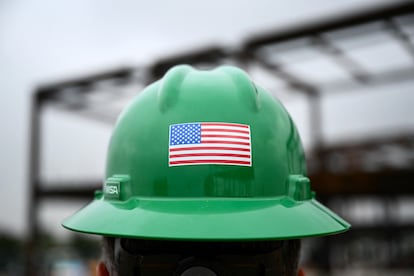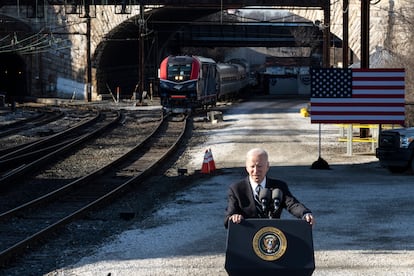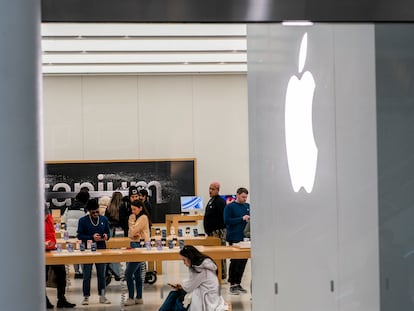The thriving US economy of discontent
The country’s growth and strong job market has done little to diminish widespread unhappiness about inflation and high interest rates


The U.S. economy is either doing well or poorly, depending on how you look at it and who’s looking. Steady economic growth, a strong job market, resilient consumer spending, attractive investment opportunities, productivity growth, and stock market highs have defied expectations. On the flip side, stubborn inflation, high interest rates, runaway government deficits and the growing public debt weigh heavily on the other end of the scale. In this election year, public perception is also paradoxical: most people feel good about their personal situations but hold a negative view of how the country is doing as a whole.
“I’ve been hearing every month that there’s going to be a recession next month,” said President Biden last summer. “I don’t think we’ll have one.” Biden was right where many economists were wrong. Even the Federal Reserve predicted a recession that never materialized. Instead, the U.S. economy grew by 2.5% last year, compared to 0.5% in the Eurozone. And the economy is roaring along in 2024, almost immune to the most aggressive interest rate hikes since the 1980s to combat the highest inflation in four decades.
Historical precedents did not favor a soft landing, a term borrowed from the space race. Just like the Odysseus recently hit some rocks and tipped sideways when landing on the moon, economists assumed that the economy would stumble with interest rate hikes and fall into a recession. Back in 1994, Alan Greenspan was the only Fed chair to forestall a recession while increasing interest rates. Current Fed Chair Jerome Powell himself cautioned about the necessary evil of harming households and businesses to control inflation.
The U.S. economy has continued to grow and create jobs at a good pace while prices remained stable. In his recent State of the Union address, Biden declared victory, saying, “The landing is and will be soft.” Powell disagreed, predicting a tough final mile toward price stability that will drop inflation from 3.2% to the 2% target.
There’s a risk of overheating the economy, causing prices to soar again. At it’s March meeting, the Federal Open Market Committee (FOMC) projected inflation will hit 2.4% and the economy will grow by 2.1% by year-end. The International Monetary Fund (IMF) upgraded U.S. growth forecasts by 0.6 points to 2.1% for this year, compared to 0.9% for the Eurozone and Japan, and 0.6% for the U.K.
The United States isn’t just the fastest-growing major economy, but also the only one that has regained the momentum disrupted by the pandemic. “Imagine you went into a coma in late 2019 and woke up in early 2024,” said University of Michigan economics professor Justin Wolfers, speaking at a recent event hosted by the Brookings Institution in Washington, D.C. “The first thing you do is ask about the economic stats, right? Well, I would. And guess what? You find out that the GDP is actually higher than when you went into the coma. So, you turn to your caregiver and ask, ‘What good stuff happened in the economy while I was out?’ And you’re blown away to hear that you slept through a pandemic and a global recession. But hey, here we are!”
Wolfers might be shocked by grocery prices following his coma, but there’s a widespread agreement that the economy has outperformed expectations. “The recovery in the United States has been remarkable, and the unemployment rate has dropped sharply,” said Jason Furman, former chair of the White House Council of Economic Advisers under president Barack Obama and a professor at Harvard University. “What took a decade after the financial crisis has happened in less than two years. Now it looks we’ll have a soft landing. I think that’s nothing short of miraculous.”
Bidenomics
When it comes to taking credit for economic achievements, the Federal Reserve deserves most of it, but President Biden has claimed a little as well. His economic policies continued the liquidity injection to families and businesses initiated by his predecessor, Donald Trump. Biden added stimulus measures to boost investment in microprocessors with the CHIPS Act; in roads, bridges, railways and airports with the Infrastructure Act; and in green energy with the Inflation Reduction Act. He has supported labor unions and even joined a picket line in Michigan; promoted business competition through antitrust cases, opposed major mergers, and took measures to lower pharmaceutical prices and excessive fees; and he implemented protectionist measures to oppose Nippon Steel’s acquisition of U.S. Steel.
The news media started calling this economic program “Bidenomics,” a label the president eventually embraced. “The press has now called it ‘Bidenomics.’ I don’t know what the hell that is. But it’s working,” said the president at June rally in Philadelphia, the first time he used the term.
The president has touted Bidenomics frequently in recent months. However, Americans for Prosperity (AFP), the influential conservative network founded by the billionaire Koch brothers, beat him to the punch by acquiring the Bidenomics.com domain. AFP, which unsuccessfully backed Nikki Haley in the Republican primaries, posts frequent criticisms of Biden’s economic policies on this website, focusing mainly on inflation, the federal deficit, debt and high interest rates. These are real issues. Prices have risen by nearly 20% during Biden’s term, affecting essential items like food and gas, which was unusually cheap during the pandemic.
The nation’s finances have been hammered by skyrocketing deficits and debt that began during the Great Recession, worsened with the pandemic, and have remained unresolved since. The public deficit doubled last year due to declining revenue, reaching the equivalent of 7.5% of the gross domestic product (GDP), despite the economic growth and job creation.
The gross national debt reached 121% of the GDP, but that figure is misleading. There is about $7 trillion of intragovernmental debt, so the number to focus on is the government debt held by investors. That figure stood at 98%, and according to the Congressional Budget Office’s (CBO) projections, it’s on track to surpass the historical peak before the end of the decade, which was 106% of the GDP in 1946, after World War II. It was at a healthy 35% in 2007, before the global financial crisis.
Interest rates have risen from near-zero to 5.25%-5.5%. This directly affects the cost of new mortgages, making it more difficult to afford a house and increasing consumer financing costs while delinquency rates soar.
However, these rate hikes have not prevented the unemployment rate from staying below 4% for 25 consecutive months, the longest period in over half a century. Since Biden took office, a historically high 15 million jobs have been created, partly driven by pandemic recovery. While the labor market shows signs of slight cooling, it remains strong and has efficiently absorbed the influx of immigrants.
Resilience
Economists have been trying to understand why the U.S. economy has shown unexpected resilience to interest rate hikes, international conflicts, banking turmoil, labor strikes and other setbacks. Consumer spending has been the key driver of the economy on the demand side. The pandemic fiscal stimulus and reduced spending due to health restrictions left Americans with full piggy banks. Federal Reserve economists estimated excess savings at a peak of $2.3 trillion in the third quarter of 2021, with around $1.7 trillion still available by mid-2022. Recent studies differ on whether this pool has been depleted or how much remains, but it has undoubtedly supported the economy, fueling what psychologists call “revenge spending.” Although it has made homeownership a more difficult goal, the increase in interest rates had little impact on people who already had mortgages, mostly long-term fixed-rate loans.
The labor market has also benefited from the perceived worker shortage. Finding workers has been harder than finding work for a long time. This has slowed down layoffs during economic downturns and prevented the typical recession cycle. “CEOs were reluctant to let people go, thinking, ‘We’ve invested a lot of time and energy in assembling this team, so we need to retain our people.’ They decided not to let people go even when they expected a brief and shallow recession,” said Dana Peterson, Chief Economist at The Conference Board during a recent meeting with reporters. Peterson, however, anticipates an economic slowdown in the near future. “We foresee flat growth by mid-year because we don’t believe consumers can sustain their current levels of consumption and spending, especially those we saw in the second half of last year.”
Energy has also played a key role in driving growth. By extracting shale from its reserves through hydraulic fracturing (fracking), the United States has set records in oil production and exports of liquefied natural gas, boosting its trade balance. Low domestic gas prices have helped reduce industrial costs.
Government tax incentives have shown promise and are already making an impact. In a recent briefing for the State Department, Mark Zandi, Chief Economist at Moody’s Analytics, said, “To give you sense of magnitude, if you go back, say, before the pandemic... manufacturers in the U.S. would spend approximately $75 billion a year to build new factories or refurbish existing factories... which in the grand scheme of things is not that much. Most recently, it’s on an annualized basis well over $200 billion, so that gives you a sense of magnitude and very dramatic kind of shift here... This dynamic is in full swing and I don’t see this changing anytime soon.”
Protectionism
Biden’s economic protectionism, through various forms of aid and incentives, has done more than Trump’s tough but empty talk and mostly symbolic tariffs. Biden has benefited from companies wanting to bring their supply chains closer after pandemic disruptions, but his economic nationalism has been vociferous. When criticism intensified from abroad (especially the European Union), Biden pushed back. “I’m getting criticized internationally for focusing too much on America. To hell with that,” he said last year to union workers in Springfield, Virginia. Biden’s opposition to the acquisition of U.S. Steel by Japan’s Nippon Steel is the latest example of his protectionist stance.
The increase in productivity is another positive development. There is debate about the root causes, but it seems that several factors have converged. Post-pandemic normalization has played a role, and labor shortages have prompted companies to enhance efficiency and automate processes. Investments in infrastructure and new factories have also contributed. The artificial intelligence boom is the cherry on top.
Despite Trump’s boasts that the prospect of his return to office has boosted stock prices, the artificial intelligence (AI) is the main reason the market has soared to historic highs. AI tech companies, led by Nvidia, have spearheaded the stock market surge. The Magnificent Seven tech stocks (Microsoft, Apple, Alphabet, Amazon, Meta, Nvidia and Tesla) have also propelled the market, defying interest rate hikes (although Tesla is struggling lately). Justin Wolfers joked that if someone had known in December 2019 that a pandemic would shut down the economy (and wars would break out in Ukraine and Gaza), they would have sold everything. Yet, the S&P 500 has surged by 40% since then.
Still, Americans are unhappy about the economy, a sentiment consistently echoed in surveys. Despite recent boosts in confidence, approval ratings of Biden’s economic stewardship remain stagnant. This can be attributed to disparities in how successes and setbacks are perceived, alongside demographic influences.
Regarding perceptions, one way to look at it is that prices have increased for everyone, while job creation has only benefited some. “The hugely impressive job market has not been reflected in an improvement in consumer sentiment,” said Jason Furman. Unemployment has been shorter and less severe than in other crises. “There’s less anxiety about getting a job, which somewhat devalued the job itself. Since most people were employed before and still are, the fear of job loss is not as prevalent.” However, due to inflation, real wages have increased at a slower pace than usual, except for the bottom 10% of the population, so “for most people, the view of the economy may not be so positive. To me, this subject is endlessly captivating and puzzling.”
Despite dropping inflation, the cost of living remains high. “People are still upset that everything is so expensive, especially essentials like food and energy. Prices are high and it’s noticeable,” said Dana Peterson. “Many consumers are frustrated about not being able to afford the homes they want, because mortgage rates — although now under 8% — are still considerably higher than in recent years.”
Then there’s the opinion polls. “There’s a big divide in how people respond to surveys,” said Wolfers. Economists Ryan Cummings and Neale Mahoney from Stanford University call it asymmetric amplification. “We find that Republicans cheer louder when their party is in control and boo louder when their party is out of control, and that adjusting the decibel level so that Republicans and Democrats cheer with equal volume explains 30% of the current gap between observed consumer sentiment and what you would predict using economic fundamentals.” They also mentioned social media’s role in magnifying negative news, media bias, and how downbeat survey responses on the economy are a form of “referred pain” from broader concerns over domestic and geopolitical events.

How will the economy influence the rematch between Biden and Trump? In the November 2022 mid-term elections, issues like democracy and abortion mattered more to voters than inflation, which was soaring at that time. The same topics continue to outweigh economic issues in the runup to the elections this November. Other prominent issues include President Biden’s age (and to a lesser extent Trump’s age), Trump’s criminal and civil charges, foreign policy, security and especially immigration and border control.
It might be too early to tell how the economy will affect election results. “Should the U.S. economy, and in particular its labor market, approach the election with their current level of buoyancy, and with more moderate inflation, this could favor the incumbent. On the other hand, in the event of a hard landing of the economy or a shift in the inflationary dynamics that pushes it back upwards, the context would be more favorable to the Republican candidate,” wrote Ricard Murillo of CaixaBank Research. Wolfers, on the other hand, believes that the current economic situation favors the president: “Considering the economy, I predict President Biden will win re-election,” he said, while acknowledging that many factors influence the way people vote.
Nomura’s Naka Matsuzawa wrote in a March report that unlike the 2016 presidential elections, Trump’s victory would not be a huge surprise to capital markets. In fact, it’s the predominant scenario at the moment: not “if Trump,” but “most likely Trump.” Many polls have shown rising approval ratings for Trump that are now higher than Biden’s. It’s unclear how extensive the impact of a “most likely Trump” scenario will be on markets, and how much it has already been factored in. Market views on the effects of a Trump win vary.
Moody’s Mark Zandi, on the other hand, believes the elections have a significant impact. “It’s very likely the election for president is going to be very close and potentially contested. That could create a lot of volatility in financial markets and undermine consumer sentiment, and that’s an issue to watch,” he said. “It’s certainly a threat, a risk in the context of the very difficult political environment that exists today in the nation.”
Sign up for our weekly newsletter to get more English-language news coverage from EL PAÍS USA Edition
Tu suscripción se está usando en otro dispositivo
¿Quieres añadir otro usuario a tu suscripción?
Si continúas leyendo en este dispositivo, no se podrá leer en el otro.
FlechaTu suscripción se está usando en otro dispositivo y solo puedes acceder a EL PAÍS desde un dispositivo a la vez.
Si quieres compartir tu cuenta, cambia tu suscripción a la modalidad Premium, así podrás añadir otro usuario. Cada uno accederá con su propia cuenta de email, lo que os permitirá personalizar vuestra experiencia en EL PAÍS.
¿Tienes una suscripción de empresa? Accede aquí para contratar más cuentas.
En el caso de no saber quién está usando tu cuenta, te recomendamos cambiar tu contraseña aquí.
Si decides continuar compartiendo tu cuenta, este mensaje se mostrará en tu dispositivo y en el de la otra persona que está usando tu cuenta de forma indefinida, afectando a tu experiencia de lectura. Puedes consultar aquí los términos y condiciones de la suscripción digital.
More information
Archived In
Últimas noticias
Maduro pleads not guilty before the federal court in New York: ‘I am still the president of Venezuela’
A new test can detect Alzheimer’s from a finger prick
UN team enters Sudanese city of El Fasher after paramilitary massacre: ‘It’s like a ghost town’
A recipe for resistance: Indigenous peoples politicize their struggles from the kitchen
Most viewed
- Gilles Lipovetsky: ‘If you want to live better and fall in love, take Prozac, don’t look to philosophy’
- Alain Aspect, Nobel laureate in physics: ‘Einstein was so smart that he would have had to recognize quantum entanglement’
- Alvin Hellerstein, a 92-year-old judge appointed by Bill Clinton, to preside over Maduro’s trial in New York
- Why oil has been at the center of Venezuela-US conflicts for decades
- Maduro’s downfall puts China’s relationship with Venezuela to the test










































